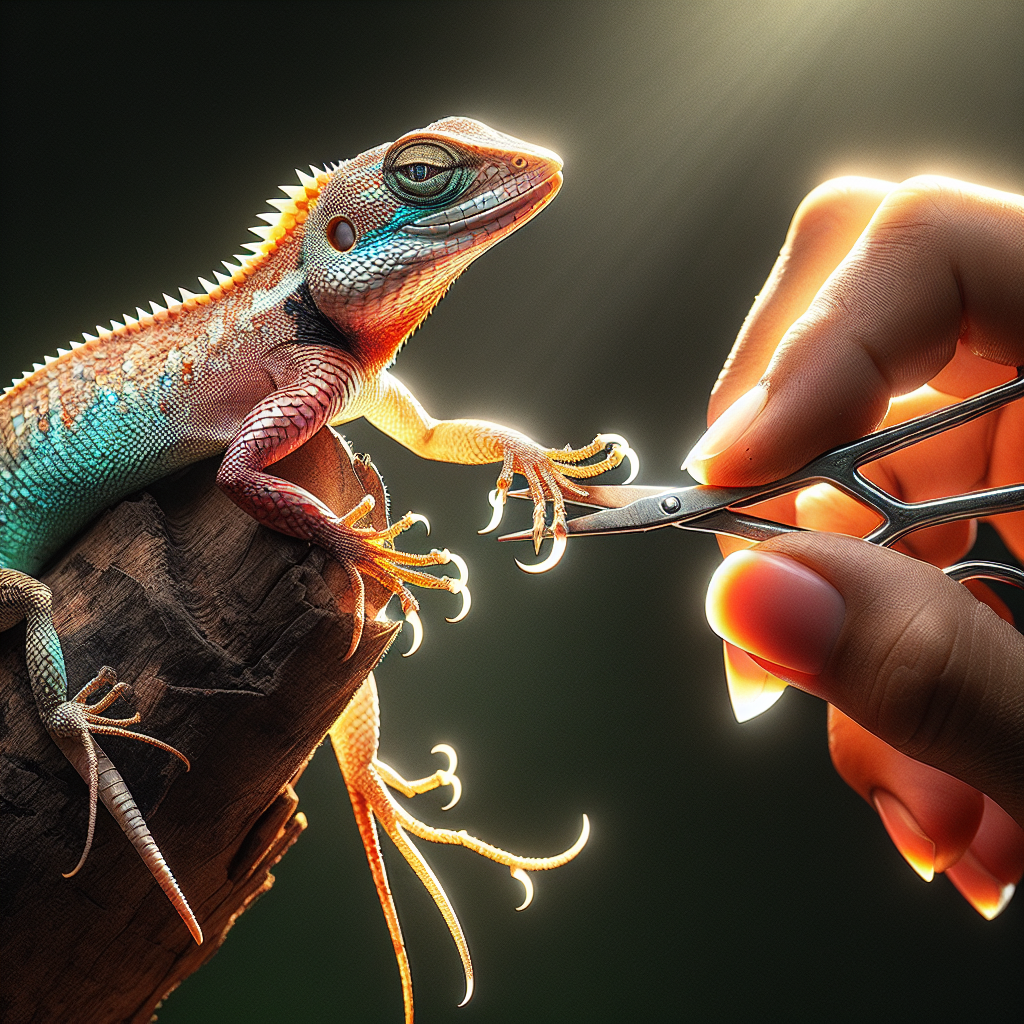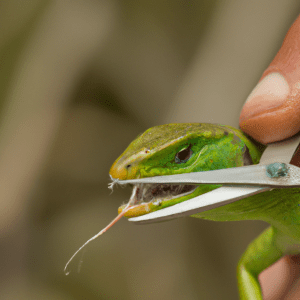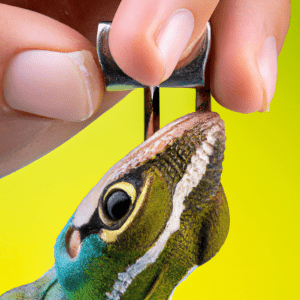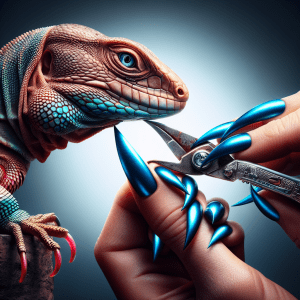Introduction: Importance of Nail Trimming in Arboreal Lizards
Have you ever wondered about the importance of trimming nails in arboreal lizards? Well, let me enlighten you on this fascinating topic. Picture this: a majestic arboreal lizard gracefully climbing tree branches in its natural habitat. Now, imagine those long nails getting in the way, hindering its movements. As an expert in the field, I can tell you that nail trimming is not just a cosmetic procedure—it’s crucial for the health and well-being of these remarkable creatures.
Arboreal lizards rely on their nails for climbing, hunting, and defending themselves. However, if their nails become overgrown, it can lead to discomfort, difficulty moving, and even potential health issues. This is where proper nail trimming comes into play. By keeping their nails at an appropriate length, you’re ensuring that your arboreal lizard can navigate its environment with ease and comfort.
Now, here’s a practical tip for you: when trimming your arboreal lizard’s nails, make sure to use specialized tools designed for reptiles to avoid any accidents or injuries. Remember, safety always comes first when caring for these unique creatures. So, the next time you observe your arboreal lizard struggling with its nails, don’t hesitate to give them a little trim. Your lizard will thank you for it, and you’ll witness firsthand the positive impact of proper nail care on their overall well-being.
Understanding the Anatomy of Arboreal Lizard Nails
Understanding the anatomy of arboreal lizard nails is crucial for successful nail trimming. These unique reptiles have specialized claws that help them grip onto branches and navigate their arboreal habitats effortlessly. Their nails are designed to provide traction and stability, allowing them to move gracefully through the treetops.
Arboreal lizards, such as geckos and anoles, have curved and sharp nails that can grow quickly if not properly maintained. These nails are essential for their survival in the wild, aiding in climbing, hunting, and defending themselves against predators. However, in captivity, overgrown nails can lead to discomfort and potential health issues for the lizards.
When it comes to trimming arboreal lizard nails, it’s essential to be gentle and patient. These creatures are sensitive, and any sudden movements or mishandling can cause stress. Using specialized tools designed for reptile nail trimming is recommended to ensure precision and safety. Take your time and work slowly to avoid accidentally cutting the quick, which can cause bleeding and pain.
By familiarizing yourself with the anatomy of arboreal lizard nails and approaching the trimming process with care and caution, you can help your pet maintain healthy and well-groomed claws. Remember, proper nail care is not only essential for your lizard’s physical health but also contributes to their overall well-being and quality of life.
Tools and Supplies Needed for Trimming
When it comes to trimming the nails of your arboreal lizards, having the right tools and supplies is crucial. Picture this: you’ve got your lizard perched on your hand, ready for a nail makeover. Now, what tools should you have on hand for this important task? Well, first things first, you’ll need a pair of high-quality nail clippers specifically designed for small reptile nails. These clippers are essential for precision and safety during the trimming process. Next up, grab a styptic powder or gel in case you accidentally cut too close to the quick and need to stop the bleeding. It’s like having a first-aid kit for your lizard’s nails! Another handy tool to have is a small file or emery board to smooth out any rough edges post-trim. Think of it as giving your lizard a mini spa treatment! And don’t forget a good light source to ensure you can see exactly where to trim without any guesswork. With these essential tools in your arsenal, you’ll be well-equipped to tackle nail trimming for your arboreal lizards like a pro. So, gather your supplies, take a deep breath, and get ready to give your lizard’s nails the TLC they deserve!
Step-by-Step Guide on How to Trim Arboreal Lizard Nails
Have you ever tried trimming the nails of your arboreal lizard on your own? It can be quite a daunting task, but with the right knowledge and tools, you can master this essential skill.
When it comes to trimming the nails of your arboreal lizard, the key is to proceed with caution. One wrong move could lead to injury, so it’s crucial to follow a step-by-step guide.
To start, make sure you have all the necessary tools at hand. Sharp nail clippers designed for reptiles are a must-have. Remember not to trim too close to the quick, as this can cause bleeding and pain for your lizard.
It’s like giving your pet a little manicure, but with a lot more care and precision involved. And trust me, your lizard will thank you for it.
Trimming their nails not only keeps them healthy but also prevents any accidents or injuries that can occur due to overgrown nails. Your little buddy will be able to climb and move around comfortably once their nails are properly trimmed.
So, next time you notice those nails getting a bit too long, don’t hesitate to give them a trim. Your arboreal lizard will appreciate the extra care and attention you provide.
Tips for Ensuring a Safe and Stress-Free Nail Trimming Experience
Alright, let’s dive into the fascinating world of trimming nails in arboreal lizards. Picture this: you’re gently holding your arboreal lizard, admiring its beautiful scales and curious eyes. Suddenly, you notice its nails are getting a bit too long. Don’t worry, it’s a common issue among lizard owners. Arboreal lizards use their sharp nails for climbing and gripping onto branches in their natural habitat. Trimming their nails is essential to prevent overgrowth and potential injuries to both your lizard and yourself. Now, here comes the tricky part – how do you safely trim those tiny nails without causing any harm? The key is to be patient, gentle, and well-prepared. Before you start, make sure to have the right tools on hand – a pair of small, sharp nail clippers designed for reptiles works best. Remember, just like us, arboreal lizards have a quick in their nails, so be cautious not to cut too close. It’s like giving your lizard a mini manicure! As you master the art of nail trimming, you’ll not only keep your arboreal lizard healthy and happy but also strengthen the bond between you and your scaly friend. So, grab those clippers and get ready to give your arboreal lizard the spa treatment it deserves!
Common Mistakes to Avoid When Trimming Arboreal Lizard Nails
When it comes to trimming the nails of arboreal lizards, there are a few common mistakes to steer clear of. Picture this: you’re all set to trim your lizard’s nails, armed with your tools and a can-do attitude. You start clipping away, but uh-oh, you accidentally cut too close, causing your lizard to squirm and you to panic. Been there, done that? It happens to the best of us, but fear not, my friend! You can avoid this mishap by ensuring you have a firm grip on your lizard’s foot and using sharp, precise clippers. Remember, patience is key! Rushing through the process can lead to errors and unnecessary stress for both you and your scaly friend. Take a deep breath, go slow, and always have some styptic powder on hand, just in case. Trust me, a steady hand and a calm demeanor will go a long way in making nail trimming a breeze for both you and your arboreal lizard. So, are you ready to master the art of nail trimming like a pro? Let’s dive in and keep those lizard nails in tip-top shape!
How Often Should You Trim the Nails of Your Arboreal Lizard?
When it comes to the frequency of trimming your arboreal lizard’s nails, there’s no one-size-fits-all answer. It really depends on your lizard’s activity level and the rate of nail growth. For most arboreal lizards, a general rule of thumb is to trim their nails every 4-6 weeks. However, keep a close eye on their nails and adjust the trimming schedule accordingly. Overgrown nails can lead to discomfort and potential health issues for your lizard, so it’s essential to stay proactive in nail maintenance.
To make the process easier, try incorporating nail trimming into your regular bonding routine with your lizard. This can help reduce stress and make the experience more positive for both of you. Remember, patience is key when it comes to nail trimming. If your lizard is particularly skittish or resistant, take breaks as needed and approach the task with a calm demeanor.
Consider using treats or positive reinforcement to reward your lizard for good behavior during the nail trimming session. This can create a positive association with the process and make future trims easier. And always have styptic powder on hand, just in case you accidentally trim too close to the quick and cause bleeding.
By staying attentive to your arboreal lizard’s nail length and implementing a consistent trimming schedule, you can help ensure their overall well-being and comfort. So, are you ready to take on the challenge of becoming a nail-trimming pro for your arboreal lizard?
Alternative Methods for Managing Arboreal Lizard Nail Length
Have you ever wondered how often you should trim the nails of your arboreal lizard? Let me shed some light on this crucial aspect of lizard care. Overgrown nails can lead to discomfort for your pet, affecting its ability to climb and move freely. It’s like wearing shoes that are too tight! To keep your arboreal lizard healthy and happy, regular nail trimming is essential. But how often should you do it? Well, there isn’t a one-size-fits-all answer. Factors like the lizard’s age, activity level, and the type of substrate in its habitat all play a role. As a general rule, it’s recommended to check your lizard’s nails regularly for signs of overgrowth. But remember, every lizard is different, so it’s essential to observe your pet’s behavior and nail length closely. If you’re unsure or uncomfortable trimming the nails yourself, don’t hesitate to seek professional help from a veterinarian experienced in reptile care. Your lizard’s well-being is worth the extra care and attention! So, the next time you’re admiring your arboreal lizard’s acrobatics, take a moment to consider their nails and whether it’s time for a trim. After all, happy feet mean a happy lizard!
Consulting a Veterinarian for Professional Nail Trimming Services
You know, when it comes to trimming the nails of arboreal lizards, it’s not just about aesthetics. It’s a crucial aspect of their overall health and well-being. Imagine climbing trees with long, unkempt nails—it’s not only uncomfortable but also risky business. And for our arboreal friends, well-maintained nails are like their climbing gear, essential for their agility and survival in the wild.
Now, here’s a practical tip for you: when it comes to trimming your arboreal lizard’s nails, it’s important to have the right tools on hand. A good pair of nail clippers designed for reptiles can make the process much smoother and safer. Remember, safety first!
But have you ever stopped to think about the broader implications of nail trimming for arboreal lizards? It’s not just about aesthetics or comfort—it’s about their overall health and happiness. By keeping their nails trimmed, you’re actually contributing to their quality of life and ensuring they can continue to thrive in their natural habitat.
So, the next time you embark on a nail trimming session with your arboreal lizard, remember that you’re not just giving them a little grooming session—you’re playing a vital role in their well-being. And who knows, maybe they’ll show their appreciation by climbing a little higher or moving a little faster with their well-maintained nails. It’s a win-win for both you and your scaly friend!
Conclusion: Maintaining Healthy Nails for Happy Arboreal Lizards
Have you ever wondered about the intricate world of trimming nails in arboreal lizards? It’s a topic that might sound trivial at first, but let me tell you, it’s crucial for the health and well-being of these unique creatures.
Imagine this: a tiny arboreal lizard effortlessly navigating its lush habitat, using its sharp nails to grip onto branches and surfaces with precision. Now, picture those nails growing longer and potentially causing discomfort or even injury to the lizard. That’s where nail trimming comes in.
Trimming the nails of arboreal lizards is not just about aesthetics; it’s about ensuring their physical health and comfort. As an expert in this field, I can attest to the importance of regular nail maintenance for these fascinating creatures.
One practical tip I always emphasize is using the right tools and techniques to trim their nails safely and effectively. It’s a delicate process that requires patience and a steady hand, but the rewards are worth it.
So, the next time you observe your arboreal lizard struggling to climb or perch, consider giving their nails some attention. By mastering the art of nail trimming, you’re not just helping your pet look its best – you’re also promoting its overall well-being and happiness.




